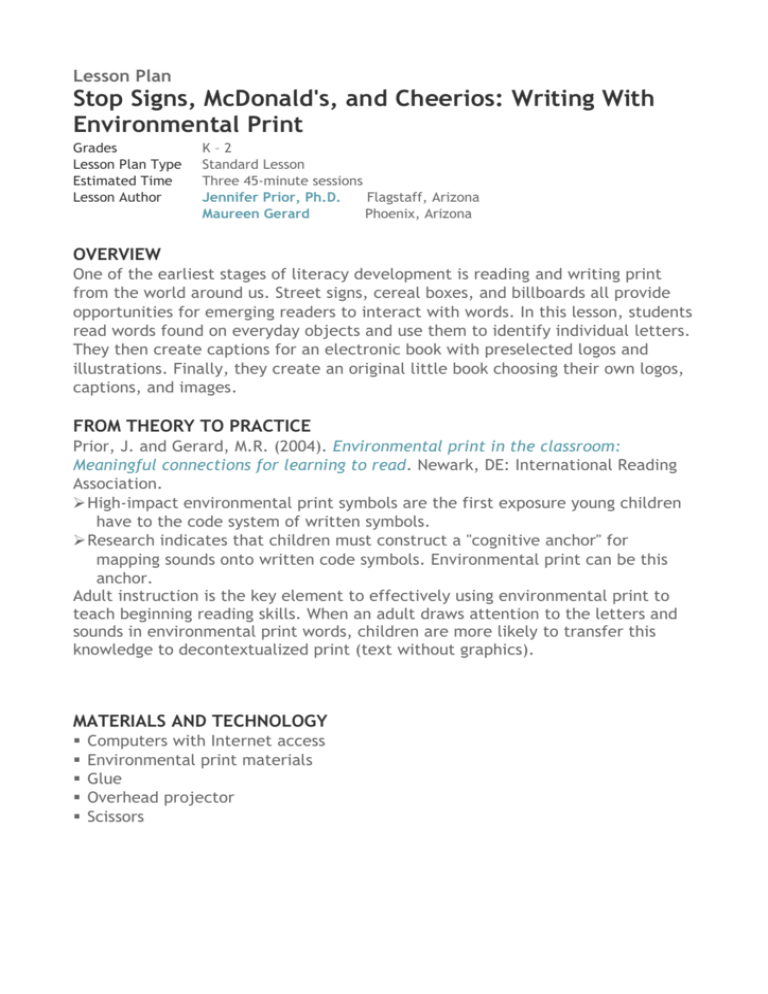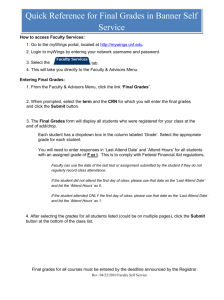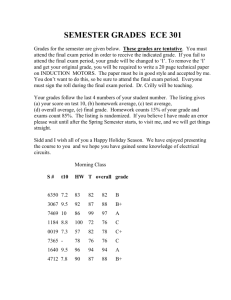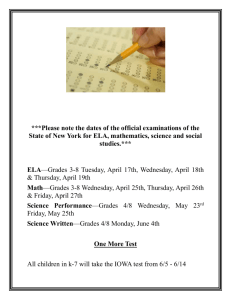
Lesson Plan
Stop Signs, McDonald's, and Cheerios: Writing With
Environmental Print
Grades
Lesson Plan Type
Estimated Time
Lesson Author
K–2
Standard Lesson
Three 45-minute sessions
Jennifer Prior, Ph.D.
Flagstaff, Arizona
Maureen Gerard
Phoenix, Arizona
OVERVIEW
One of the earliest stages of literacy development is reading and writing print
from the world around us. Street signs, cereal boxes, and billboards all provide
opportunities for emerging readers to interact with words. In this lesson, students
read words found on everyday objects and use them to identify individual letters.
They then create captions for an electronic book with preselected logos and
illustrations. Finally, they create an original little book choosing their own logos,
captions, and images.
FROM THEORY TO PRACTICE
Prior, J. and Gerard, M.R. (2004). Environmental print in the classroom:
Meaningful connections for learning to read. Newark, DE: International Reading
Association.
High-impact environmental print symbols are the first exposure young children
have to the code system of written symbols.
Research indicates that children must construct a "cognitive anchor" for
mapping sounds onto written code symbols. Environmental print can be this
anchor.
Adult instruction is the key element to effectively using environmental print to
teach beginning reading skills. When an adult draws attention to the letters and
sounds in environmental print words, children are more likely to transfer this
knowledge to decontextualized print (text without graphics).
MATERIALS AND TECHNOLOGY
Computers with Internet access
Environmental print materials
Glue
Overhead projector
Scissors
STUDENT INTERACTIVES
Stapleless Book SEE APPENDIX
The Stapleless Book can be used for taking notes while reading, making picture
books, collecting facts, or creating vocabulary booklets . . . the possibilities are
endless!
WEBSITES
Google Images
PREPARATION
1.
You may choose to teach this lesson as part of a unit along with
“I Know That Word! Teaching Reading With Environmental Print.”
If you have already completed this lesson, you can use the environmental
print materials you assembled for it and can skip Session 1 of this lesson,
which is the same.
2.
You will be using examples of signs, labels, and logos with your students and
should have a collection available both to share with them during Session 1 and
for them to use to create their books in Session 3. These can come from product
packaging (i.e., cereal boxes, soda cans), fast food containers, store bags, or
magazines. At least six of these images should come specifically from your
immediate community (i.e., the sign in front of your school or street signs from
main streets in town). You might consider taking photos of local signs with a
digital camera or scanning in pictures that you cut out of local magazines or
brochures. You should both print these local images and save them on your
computer.
3.
You can also use the Internet to capture images of signs, logos, and product
labels as follows:
Go to Google Images and type in the name of a sign, company, or product
you
a. Go
would
to Google
like toImages
use with
and
students
type in (for
the name
example,
of atype
sign,incompany,
the wordsorstop
sign).
product you would like to use with students (for example, type in the
words stop sign).
On the page that opens with images, click on the image that is simplest
and
b. On
will
the
copy
page
most
thatclearly;
opens with
then images,
click on click
the link
on the
thatimage
says See
thatfull-size
is simplest
image.
and will copy most clearly; then click on the link that says See full-size
image.
When this image opens, right click on the image. A drop-down menu will
appear.
c. WhenClick
this image
on the opens,
word Copy.
right click on the image. A drop-down menu
will appear. Click on the word Copy.
Using Microsoft Word or another word-processing program, open up a
blank
d. Using
document
Microsoft
and
Word
paste
orthe
another
imageword-processing
in. Right click on
program,
the image
open
to up
geta
the
blank
Picture
document
menu,and
which
paste
will
the
give
image
you in.
theRight
tools click
to shrink
on the
or image
enlarge
toitget
as
necessary.
the Picture menu, which will give you the tools to shrink or enlarge it as
necessary.
e. Print copies of the images to share with students during Session 1 and
additional copies for students to use when creating their books during
Session 3.
4.
Visit and familiarize yourself with the Stapleless Book. Use
the tool to create a blank little book that you title "My Little Book." For each page,
choose either of the templates from the second row (with the image above or
below the text). You want to leave most of the text area blank, including only
page numbers. After you print the book, paste or tape the six local images you
have chosen (see Step 1) onto the pages and make a transparency. Make one copy
for each student in your class. Read the folding directions so that you can help
students assemble their books at the end of Sessions 2 and 3.
5.
If you do not have classroom computers, reserve one session in your school's
computer lab (see Session 3). Save the Stapleless Book in the Favorites list
on the computers your students will be using.
6.
Ask your students to bring in their own examples of packaging, labels, and
logos to share during Session 1.
INSTRUCTIONAL PLAN
Student Objectives
Session 1: Discussion of Print in the Environment
Session 2: Writing a Book Using Local Images
Session 3: Creating an Original Little Book With Environmental Print Words
Extensions
Student Assessment/Reflections
STUDENT OBJECTIVES
Students will
Develop word recognition and fluency by identifying and discussing familiar
print in the environment, by taking note of individual letters in the words, and
by segmenting the sounds of these letters
Practice writing skills by creating captions to accompany familiar environmental
symbols that have been selected for them and those that they choose
themselves
Practice early reading success by reading their own writing aloud
SESSION 1: DISCUSSION OF PRINT IN THE ENVIRONMENT
1.
Display the items you have assembled to share and those that your students
have brought in (see Preparation, Steps 2 and 6). Ask students to identify each
of them. Ask how they know the name of the item and have student volunteers
point to the words on the packaging.
2.
Use the words on the items you have brought in to draw students’ attentions to
the letters and sounds. For example:
How do you know this box says BAND-AID?
What letter do you see at the beginning?
What sounds does the letter b make?
Is that the sound you hear at the beginning of BAND-AID?
What is another word that begins with the same sound?
Slowly segment the sounds made by each environmental print word and have
students call out the letter for each sound. Draw students’ attentions to the
different sounds that the same letter can make. For example:
What other letters do you see in the word BAND-AID?
What are the sounds that you hear in BAND-AID?
Do you see the letter a here in BAND-AID says /ă/, but the letter a here says
its name /ā/.
Proceed in this manner with each of the items. Draw students’ attentions to the
fact that often a letter appears in different ways. For example, sometimes a
letter might be written in cursive. Sometimes the same letter is big and red.
The same letter can look different when it appears in different words.
3.
4.
SESSION 2: WRITING A BOOK USING LOCAL IMAGES
1.
Display the transparency of the Stapleless Book (see Preparation, Step 4).
Distribute the copies you made to your students.
2.
Review each of the images, asking students to say the environmental print word
or words. Ask them how they know the word. What letter do they see at the
beginning of the word? What sound does that letter make? As you work through
the pages, you should turn the transparency so that students are looking at the
image the right way up.
3.
Next, explain to students that they should add captions or write sentences to go
with each image.
4.
Using the transparency and a marker, model completing this task with the first
image. Be sure to include the environmental print word or words in your caption.
For example, if the image is of your school’s sign, you might write, “I am a
teacher at Westside Elementary School.” Ask students to help you compose the
caption for the other three images, writing on the transparency as you go. Again,
make sure you turn the transparency so that the image you are working on is
facing the right direction.
5.
Students should fill in their own Stapleless Book sheets. Circulate and assist them
as needed. When they are finished, show them how to fold and cut the book.
6.
Ask students to read their completed books out loud.
SESSION 3: CREATING AN ORIGINAL LITTLE BOOK WITH ENVIRONMENTAL
PRINT WORDS
1.
Have students choose six images from the collection you have assembled
(see Preparation, Steps 1 and 2).
2.
Students should then access the Stapleless Book. They should title their books
"My Little Book." Help them create the pages using the same templates you did
when you made yours. Explain that they will glue one of the logos they have
chosen onto each page and should write captions or sentences to accompany the
logos as they did during Session 2. They should use the words that appear in the
images in each caption and should number each page. You may choose to have
them write the page numbers on the back of the images they have chosen, to help
them match up the pages and the images correctly. Make sure studnets print
their books when they are done.
3.
When the books are printed, students should glue the signs or logos onto the
proper pages and should fold and cut them as they did during Session 2.
4.
Have students pair up to read their books to each other.
EXTENSIONS
1. For further development of word recognition and fluency, invite students to
read their completed books to students in another class.
2. Have students take their completed books home to read to family members as
homework.
3. Extend what students have learned by playing Environmental Print Bingo with
students. “Bingo! Using Environmental Print to Teach Reading” has students
make Bingo cards using the logos from this lesson.
4. The lesson plan “From Stop Signs to the Golden Arches: Environmental Print”
provides students with additional practice reading environmental print. After
collecting examples and sorting them into categories, students make a class
book.
STUDENT ASSESSMENT/REFLECTIONS
Observe students’ participation during the group activities, especially to their
ability to read logo words and identify letters and sounds. Pay close attention
to how easily students segment and hear the sounds of the letters in each
environmental print word.
During Session 2, observe as students make attempts to write decontextualized
words. Make note of any difficulty they experience with particular letters.
Review both books each student creates. Check for length of captions or
sentences. In the second one, make sure they have pasted the correct images
to accompany their text. Observe temporary spellings in the book to assess the
stage of writing development for each student. When necessary, assist the
student in clarifying his or her understanding.
On a class list, note which letters are recognized readily by which students. In
addition, note what types of text are added to students’ books. Make note of
your assessment of the stage of writing development.
APPENDIX
Student Interactive
Stapleless Book
http://www.readwritethink.org/classroom-resources/student-interactives/staplelessbook-30010.html
Grades
Interactive Type
Tech
Requirement
URL
K – 12
Writing & Publishing Prose
Acrobat Reader required
Flash Player required
http://www.readwritethink.org
/files/resources/interactives
/stapleless/
ABOUT THIS INTERACTIVE
Overview
Lessons That Use This Interactive
Related Classroom & Professional Development Resources
Overview
The Stapleless Book is designed to allow users to create with ease an eight-page
book simply by folding and cutting. No tape or staples are required. Students and
teachers alike can use the Stapleless Book for taking notes while reading, making
picture books, collecting facts, or creating vocabulary booklets. Students can
choose from seven different layouts for the pages of their books.
The tool is
easy to use, made even easier with the Stapleless Book Planning Sheet, a
printable PDF that book creators can use to draft and revise their work before
creating and printing their final books. View the video demonstration for the
Stapleless Book to see how to fold and cut the printout.
For additional ideas on
how to use this tool, see Stapleless Book in the Parent & Afterschool Resources
section.
Lessons That Use This Interactive
SAMPLE ACTIVITIES USING THE STAPLELESS BOOK – click on Activity title
for more details and go to the website 4 more ideasb(go to the weack to
top
Grades K – 1 | Lesson Plan | Standard Lesson
Name Talk: Exploring Letter-Sound Knowledge in the Primary Classroom
Students demonstrate their letter/sound knowledge by working with name cards
and sharing observations about their classmates’ names, giving teachers an
opportunity to assess knowledge in a meaningful context.
Grades K – 2 | Lesson Plan | Unit
Reading Everywhere with Dr. Seuss
Young readers create a classroom book modeled after Dr. Seuss's Green Eggs and
Ham to celebrate all the places they can read
Grades K – 2 | Lesson Plan | Standard Lesson
Using a Predictable Text to Teach High-Frequency Words
After reading an engaging yet predictable text about a child looking for his cat,
students use a similar format and high-frequency words to craft tales about their
own lost pets.
Grades K – 2 | Lesson Plan | Standard Lesson
Book Buddy Biographies: Intermediate and Primary Students Working Together
Students create a personalized biography for their reading buddy, and each child
is the author, illustrator, and editor.
Grade K | Lesson Plan | Standard Lesson
A Getting-Acquainted Activity Using My Teacher’s Secret Life
Students build classroom community as they get to know each other and their
teacher better by sharing what they like to do outside school.
Grades K – 5 | Lesson Plan | Standard Lesson
Spelling Cheerleading: Integrating Movement and Spelling Generalizations
"2-4-6-8, students will be spelling great" in this lesson that teaches the y rule for
adding suffixes through cheering the spelling of words aloud, word sorts, and
writing stories.
Grades K – 2 | Lesson Plan | Unit
Junie B. Jones Introduces Literacy Mystery Boxes
Like Junie B. Jones, students will be saying "Wait till you hear this" after listening
to a Junie B. story and creating mystery boxes to help retell the story.
Grades K – 2 | Lesson Plan | Standard Lesson
Exploring Sets through Math-Related Book Pairs
After reading two math-related books, students investigate their home and school
environments to find examples of objects that come in sets and then create their
own books on sets.
Grades K – 2 | Lesson Plan | Standard Lesson
As Slippery as an Eel: An Ocean Unit Exploring Simile and Metaphor
Students play with simile and metaphor as they study the ocean and use
figurative language to write a class book about it.
Grades K – 2 | Lesson Plan | Standard Lesson
How Does My Garden Grow? Writing in Science Field Journals
Students plant a garden and study its growth using the inquiry process of
questioning and exploring. As they research and study, students record their
observations in a field journal.
Grades K – 2 | Lesson Plan | Standard Lesson
Shhh! Bear's Sleeping: Learning About Nonfiction and Fiction Using ReadAlouds
Students explore the distinction between the fiction story Bear Snores On and the
nonfiction book Every Autumn Comes the Bear.
Grades K – 2 | Lesson Plan | Standard Lesson
Stop Signs, McDonald's, and Cheerios: Writing With Environmental Print
Students use logos from everyday life to identify individual letters and then
create their own captions for the images.
Grades K – 2 | Lesson Plan | Standard Lesson
The Wonder of Leo Lionni: Increasing Comprehension with Prediction
Statements
This lesson focuses on the strategy of "wonder" statements, asking students to
stop, think, and write about what may be happening in the text periodically as
they read a story.
Grades K – 2 | Lesson Plan | Standard Lesson
Let's Read It Again: Comprehension Strategies for English-Language Learners
Help Spanish-speaking English-language learners unlock the mysteries of their
new language by using a bilingual book to recognize unfamiliar words and
construct meaning from the text.
Grades K – 2 | Lesson Plan | Standard Lesson
Family Ties: Making Connections to Improve Reading Comprehension
Families are all about connections between people. In this book, students read
three books about different families and make text-to-self, text-to-text, and
text-to-world connections to those texts.
Related Classroom & Professional Development Resources
Grades 6 – 8 | Lesson Plan | Unit
Let It Grow: An Inquiry-Based Organic Gardening Research Project
Students learn about organic gardening by developing their own research
questions, conducting research, gardening at their school, creating signs about
their plants, and presenting their research to the class.
Grades 3 – 12 | Student Interactive | Writing & Publishing Prose
Flip Book
The Flip Book is designed to allow users to type and illustrate tabbed flip books
up to ten pages long. Students and teachers can use the flip book for taking notes
while reading, making picture books, collecting facts, or creating question and
answer booklets.
Grades K – 12 | Student Interactive | Writing & Publishing Prose
ReadWriteThink Printing Press
The interactive Printing Press is designed to assist students in creating
newspapers, brochures, flyers, and booklets.
Grades K – 8 | Student Interactive | Writing & Publishing Prose
Book Cover Creator
The Book Cover Creator is designed to allow users to type and illustrate front
book covers, front and back covers, and full dust jackets. Students can use the
tool to create new covers for books that they read as well as to create covers for
books they write individually or as a class.
Grades 3 – 12 | Calendar Activity | October 3
Gwendolyn Brooks published Bronzeville Boys and Girls in 1956.
After students have read and discussed several poems from Brooks' collection,
they create a poetry anthology for their own family, neighborhood, or classroom.
Grades K – 5 | Strategy Guide
Implementing the Writing Process
This strategy guide explains the writing process and offers practical methods for
applying it in your classroom to help students become proficient writers.
© 2010 IRA/NCTE. All rights reserved.
Technical Help | Legal | International Reading Association |
National Council of Teachers of English






